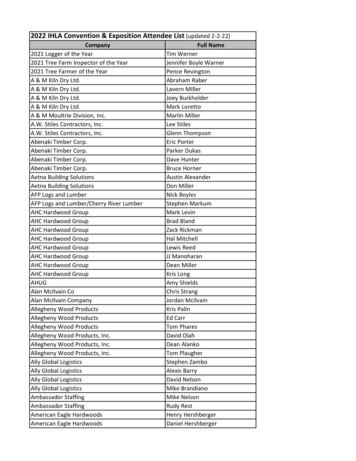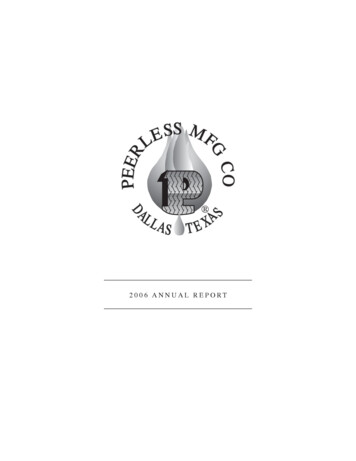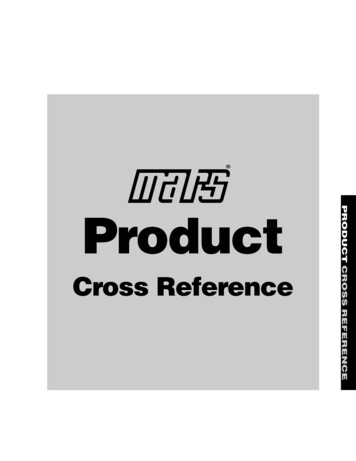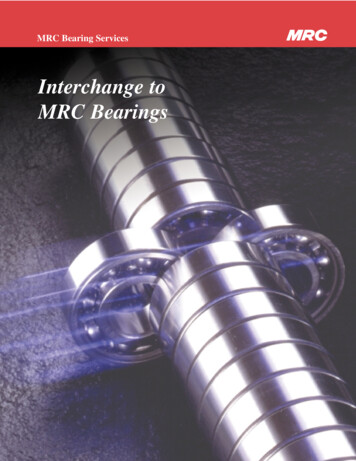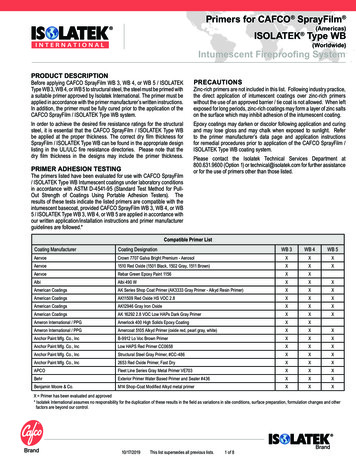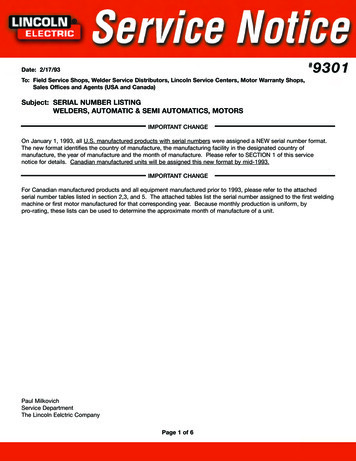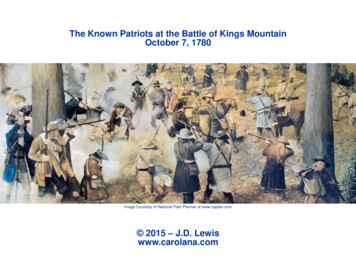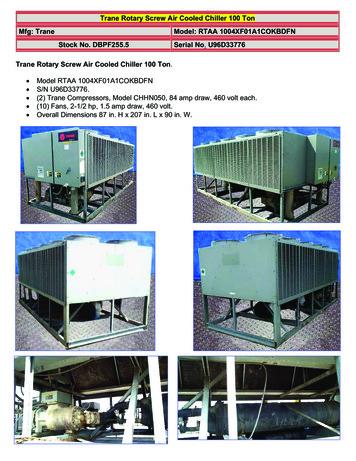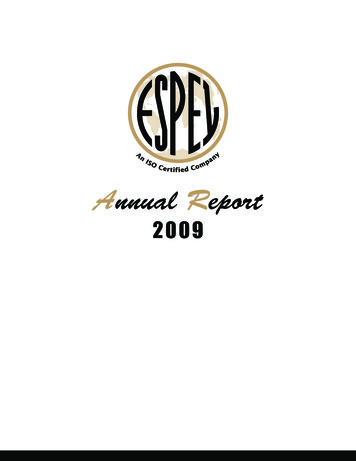
Transcription
Annual Report2009
E SP E Y MF G. & ELECTRONICS CORP.BOARD OF DIRECTORSHoward PinsleyChief Executive Officer and Chairman of the BoardEspey Mfg. & Electronics Corp.Paul J. Corr, CPA / PFS / CFP Principal Capital Financial Advisors of New York, LLCClifton Park, New YorkCarl HelmetagVice President SalesAlphaMicron, Inc., Kent, OhioBarry Pinsley, CPACertified Public AccountantSaratoga Springs, New YorkAlvin O. SaboAttorney at Law, Albany, New YorkSeymour SaslowRetiredFormer Senior Vice PresidentEspey Mfg. & Electronics Corp.Michael W. WoolSenior Partner, Langrock, Sperry & WoolBurlington, VermontOFFICERSHoward Pinsley, Chief Executive Officer and Chairman of the BoardMark St. Pierre, PresidentDavid A. O’Neil, Treasurer and Principal Financial OfficerJames Clemens, Vice President of Sales and MarketingKatrina Sparano, Assistant Treasurer and Principal Accounting OfficerPeggy A. Murphy, Corporate Secretary and Director of Human ResourcesCorporate COUNSELGibbons P.C.One Gateway CenterNewark, NJ 07102REGISTRAR AND TRANSFER AGENTRegistrar and Transfer Company10 Commerce DriveCranford, New Jersey 07016A copy of the Company’s Annual Report on Form 10-K (including financial statements) for the fiscal yearended June 30, 2009 filed with the Securities and Exchange Commission will be provided without chargeupon written request of shareholders to Espey Mfg. & Electronics Corp., attention: Investor Relations,233 Ballston Avenue, Saratoga Springs, New York 12866. The report on Form 10-K can also be viewedelectronically at www.espey.com.
CHAIRMAN’S MESSAGEFellow Shareholders:Our sales order backlog and investments made by the Company in newprograms during the past two years positions the Company for growth insales and earnings in fiscal 2010.Revenues for Fiscal 2009 increased 6% to 27,241,635 from 25,701,738in Fiscal 2008, while earnings decreased from 1.63 per diluted share to 1.29 per diluted share. During theyear ended June 30th, 2009, the reduced earnings were directly attributable to our investments in several newprograms with excellent future prospects. The fourth quarter in fiscal 2009, was the best quarter for revenuesand earnings in the eighty-one year history of our Company, with revenues of 8,284,060 and earnings of .75per diluted share.During the fiscal year 2009, Espey common stock ranged from a low of 13.05 per share in the third quarter toa high of 22.00 in the first quarter. At the time of this message, the stock is trading at 18.75 per share.For the fiscal year ending June 30th, 2009, a total of 2.40 per share in dividends were paid, including a specialdividend of 1.50 per share. The Board of Directors had declared a regular first quarter dividend for the fiscal yearending June 30, 2010 of .225 per share. The dividend was payable on September 25, 2009, to all shareholdersof record at September 4, 2009.On behalf of your board of Directors, and myself we extend our appreciation to all of our shareholders, employees,customers and suppliers, for their continued confidence and support.Howard PinsleyChairman of the Board
UNITED STATESSECURITIES AND EXCHANGE COMMISSIONWashington, DC 20549FORM 10 – K6 ANNUAL REPORT PURSUANT TO SECTION 13 OR 15 (d) OF THE SECURITIES EXCHANGE ACT OF1934 for the fiscal year ended June 30, 2009ORTRANSITION REPORT PURSUANT TO SECTION 13 OR 15 (d) OF THE SECURITIES EXCHANGE ACTtooOF 1934 for the transition period fromCommission file number 1-4383ESPEY MFG. & ELECTRONICS CORP.(Exact name of registrant as specified in its charter)NEW YORK(State or other jurisdiction of incorporation or organization)14-1387171(IRS Employer Identification No.)233 Ballston Avenue, Saratoga Springs, NY 12866(Address of principal executive offices including Zip Code)(Registrant's telephone number including area code) (518)245-4400Securities registered pursuant to Section 12(b) of the Act:Name of each exchange on which registeredTitle of each classCommon Stock .33-1/3 par valueNYSE - AmexCommon Stock Purchase RightsNYSE - AmexSecurities registered pursuant to Section 12 (g) of the Act: NoneIndicate by check mark if the registrant is a well-known seasoned issuer, as defined in Rule 405 of theSecurities Act.Yes 6 NoIndicate by check mark if the registrant is not required to file reports pursuant to Section 13 or Section 15(d) ofthe Act.Yes 6 NoIndicate by check mark whether the registrant (1) has filed all reports required to the filed by Section 13 or 15(d) of the Securities Exchange Act of 1934 during the preceding 12 months (or for such shorter period that theregistrant was required to file such reports), and (2) has been subject to such filing requirements for the past 90 days.6 YesNoIndicate by check mark if disclosure of delinquent filers pursuant to Item 405 of Regulation S-K is notcontained herein, and will not be contained, to the best of registrant's knowledge, in definitive proxy or informationstatements incorporated by reference in Part III of this Form 10-K or any amendment to this Form 10-K.Indicate by check mark whether the registrant is a large accelerated filer, an accelerated filer, a non-acceleratedfiler, or a smaller reporting company:Large accelerated filerAccelerated filerNon-accelerated filer 6 Smaller reporting companyYes 6 NoIndicate by check mark whether the registrant is a shell company.The aggregate market value of the voting stock held by non-affiliates of the registrant was 26,659,835 basedupon the closing sale price of 18.16 on the NYSE - Amex on December 31, 2008.At September 8, 2009, there were 2,314,803 shares outstanding of the registrant's Common stock, .33-1/3 parvalue.DOCUMENTS INCORPORATED BY REFERENCEPortions of the registrant's definitive proxy statement relating to the 2009 Annual Meeting of Shareholders, tobe filed with the Securities and Exchange Commission, are incorporated by reference in Part III, Items 10 through14 on Form 10-K as indicated herein.11
Forward-Looking StatementsThis Annual Report on Form 10-K contains forward-looking statements that are based on management’sexpectations, estimates, projections and assumptions. Words such as “expects,” “anticipates,” “plans,” “believes,”“scheduled,” “estimates” and variations of these words and similar expressions are intended to identify forwardlooking statements. Forward-looking statements are made pursuant to the safe harbor provisions of the PrivateSecurities Litigation Reform Act of 1995, as amended. These statements are not guarantees of future performanceand involve certain risks and uncertainties that are difficult to predict. Therefore, actual future results and trendsmay differ materially from what is forecast in forward-looking statements due to a variety of factors, including,without limitation: Changing priorities in the U.S. government’s defense budget (including changes in priorities in response toterrorist threats or to improve homeland security); Termination of government contracts due to unilateral government action; Differences in anticipated and actual program performance, including the ability to perform under longterm fixed-price contracts within estimated costs, and performance issues with key suppliers andsubcontractors; Potential of changing prices for energy and raw materials.All forward-looking statements speak only as of the date of this report or, in the case of any document incorporatedby reference, the date of that document. All subsequent written and oral forward-looking statements attributable tothe Company or any person acting on the Company’s behalf are qualified by the cautionary statements in thissection. The Company does not undertake any obligation to update or publicly release any revisions to forwardlooking statements to reflect events, circumstances or changes in expectations after the date of this report.22
Item 1. BusinessPART IGeneralEspey Mfg. & Electronics Corp. (the "Company") located in Saratoga Springs, New York, is engaged principally inthe development, design, production and sale of specialized electronic power supplies, a wide variety oftransformers and other types of iron-core components, and electronic system components. In some cases, theCompany manufactures such products in accordance with pre-developed mechanical and electrical requirements(“build to print”). In other cases, the Company is responsible for both the overall design and manufacture of theproduct. The Company does not generally manufacture standardized components and does not have a product line.The Company operates a one-segment business and was incorporated in 1928.The electronic power supplies and components manufactured by the Company find application principally in (i)shipboard and land based radar, (ii) locomotives, (iii) aircraft, (iv) short and medium range communication systems,(v) navigation systems and (vi) land based military artillery.The Company's iron-core components include (i) transformers of the audio, power and pulse types, (ii) magneticamplifiers and (iii) audio filters. The electronic system components manufactured by the Company include antennasystems and high power radar transmitters. These system components utilize the Company's own electronic powersupplies, transformers and other iron-core components and mechanical assemblies.In the fiscal years ended June 30, 2009 and 2008, the Company's total sales were 27,241,635 and 25,701,739,respectively. Sales to two customers accounted for 33% and 30% of total sales in 2009. Sales to two customersaccounted for 31% and 25% of total sales in 2008.Export sales in 2009 and 2008 were approximately 4,691,000 and 5,538,000, respectively.Sources of Raw MaterialsThe Company has never experienced any significant delay or shortage with respect to the purchase of raw materialsand components used in the manufacture of its products, and has at least two potential sources of supply for amajority of its raw materials. However, certain components used in our products are available from only a limitednumber of sources, and other components are only available from a single source. Despite the risk associated withlimited or single source suppliers, the benefits of higher quality goods and timely delivery minimize and often limitany potential risk and can eliminate problems with part failures during production.Sales BacklogAt September 8, 2009, the Company's backlog was approximately 38.3 million. The total backlog at June 30, 2009was approximately 39.1 million compared to approximately 44.8 million at June 30, 2008. The Company’s totalbacklog represents the estimated remaining sales value of work to be performed under firm contracts. TheCompany's backlog and risks associated with government contracts is discussed in greater detail in Management'sDiscussion and Analysis of Financial Condition and Results of Operations, contained in Item 7 below.It is presently anticipated that a minimum of 29.6 million of orders comprising the June 30, 2009 backlog will befilled during the fiscal year ending June 30, 2010. The minimum of 29.6 million does not include any shipments,which may be made against orders subsequently received during the fiscal year ending June 30, 2010. The estimateof the June 30, 2009 backlog to be shipped in fiscal 2010 is subject to future events, which may cause the amount ofthe backlog actually shipped to differ from such estimate.Marketing and CompetitionThe Company markets its products primarily through its own direct sales organization. Business is solicited fromlarge industrial manufacturers and defense companies, the government of the United States, foreign governmentsand major foreign electronic equipment companies. In certain countries the Company has external salesrepresentatives to help solicit and coordinate foreign contracts. The Company is also on the eligible list ofcontractors of agencies of the United States Department of Defense and generally is automatically solicited by suchagencies for procurement needs falling within the major classes of products produced by the Company. In addition,the Company directly solicits bids from the United States Department of Defense for prime contracts.33
There is competition in all classes of products manufactured by the Company from divisions of the largest electroniccompanies, as well as many small companies. The Company's sales do not represent a significant share of theindustry's market for any class of its products. The principal methods of competition for electronic products of botha military and industrial nature include, among other factors, price, product performance, the experience of theparticular company and history of its dealings in such products. The Company, as well as other companies engagedin supplying equipment for military use, is subject to various risks, including, without limitation, dependence on theUnited States. and foreign government appropriations and program allocations, the competition for availablemilitary business, and government termination of orders for convenience.The Company's business is not considered to be seasonal. Also, management believes that due to the nature of theCompany's business the Company will not be adversely affected by recessionary factors in the U.S. economygenerally.Research and DevelopmentThe Company's expenditures for research and development were approximately 40,678 and 53,586 in fiscal 2009and 2008, respectively. Some of the Company's engineers and technicians spend varying degrees of time on eitherdevelopment of new products or improvements of existing products.EmployeesThe Company had 168 employees as of September 8, 2009. Some of these employees are represented by theInternational Brotherhood of Electrical Workers Local #1799. A new collective bargaining agreement was approvedin June 2008. The four-year agreement expires on June 30, 2012. The contract includes pay increases of 4%,3.75%, 3.75% and 4% for each year, respectively, of the four-year contract. Relations with the Union areconsidered good. Union membership at September 8, 2009 was 70 people.Government RegulationsCompliance with federal, state and local provisions that have been enacted or adopted to regulate the discharge ofmaterials into the environment, or otherwise relating to the protection of the environment, did not in fiscal year2009, and the Company believes will not in fiscal year 2010, have a material effect upon the capital expenditures,net income, or competitive position of the Company.The Company’s U.S. government contract and subcontract orders are funded by government budgets, which operateon an October-to-September fiscal year. In February of each year, the President of the United States presents toCongress a proposed budget for the upcoming fiscal year. This budget includes recommended appropriations forevery federal agency and is the result of months of policy and program reviews throughout the executive branch.From February through September of each year, the appropriations and authorization committees of Congressreview the President’s budget proposals and establish the funding levels for the upcoming fiscal year inappropriations and authorization legislation. Once these levels are enacted into law, the Executive Office of thePresident administers the funds to the agencies.There are two primary risks associated with this process. First, the process may be delayed or disrupted because ofcongressional schedules, negotiations over funding levels for programs or unforeseen world events, which could, inturn, alter the funding for a program or contract. Second, funding for multi-year contracts can be changed by futureappropriations, which could affect the timing of funds, schedules and program content.Also, our international sales are denominated in United States currency. Consequently, changes in exchange ratesthat strengthen the United States dollar could increase the price in local currencies of our products in foreignmarkets and make our products relatively more expensive than competitors’ products.U.S. Government Defense Contracts and SubcontractsGenerally, U.S. government contracts are subject to procurement laws and regulations. Some of the Company’scontracts are governed by the Federal Acquisition Regulation (FAR), which lays out uniform policies andprocedures for acquiring goods and services by the U.S. government, and agency-specific acquisition regulationsthat implement or supplement the FAR. For example, the Department of Defense implements the FAR through theDefense Federal Acquisition Regulation (DFAR).44
The FAR also contains guidelines and regulations for managing a contract after award, including conditions underwhich contracts may be terminated, in whole or in part, at the government’s convenience or for default. If a contractis terminated for the convenience of the government, a contractor is entitled to receive payments for its allowablecosts and, in general, the proportionate share of fees or earnings for the work done. If a contract is terminated fordefault, the government generally pays for only the work it has accepted. These regulations also subject thecompany to financial audits and other reviews by the government of its costs, performance, accounting and generalbusiness practices relating to its contracts, which may result in adjustment of the company’s contract-related costsand fees.Item 2. PropertyThe Company's entire operation, including manufacturing and engineering facilities, is located in Saratoga Springs,New York.The Saratoga Springs plant, which the Company owns, consists of various adjoining one-story buildings on a 22acre site, approximately eight acres of which is unimproved. The property is not subject to mortgage indebtednessor any other material encumbrance. The plant has a sprinkler system throughout and contains approximately 151,000square feet of floor space, of which 90,000 is used for manufacturing, 24,000 for engineering, 33,000 for shippingand climatically secured storage, and 4,000 for offices. The offices, engineering and some manufacturing areas areair-conditioned. In addition to assembly and wiring operations, the plant includes facilities for varnishing, potting,plating, impregnation and spray-painting operations. The manufacturing operation also includes a complete machineshop, with welding and sheet metal fabrication facilities adequate for substantially all of the Company's currentoperations. Besides normal test equipment, the Company maintains a sophisticated on-site environmental testfacility. In addition to meeting all of the Company's in-house needs, the plating, machine shop and environmentalfacilities are available to other companies on a contract basis.Item 3. Legal ProceedingsNoneItem 4. Submission of Matters to a Vote of Security HoldersNone55
PART IIItem 5. Market for the Registrant's Common Equity and Related Stockholder Matters and Issuer Purchases ofEquity SecuritiesPrice Range of Common StockThe table below shows the range of high and low prices for the Company's common stock on the NYSE - Amex(ticker symbol "ESP"), the principal market for trading in the common stock, for each quarterly period for the lasttwo fiscal years ended June 30:2009First QuarterSecond QuarterThird QuarterFourth 4.302008First QuarterSecond QuarterThird QuarterFourth 7.40HoldersThe approximate number of holders of record of the common stock was 109 on September 8, 2009 according torecords of the Company's transfer agent. Included in this number are shares held in "nominee" or "street" name and,therefore, the number of beneficial owners of the common stock is believed to be substantially in excess of theforegoing number.DividendsThe Company paid cash dividends on common stock of 2.40 and 2.25 per share for the fiscal years ended June30, 2009 and 2008, respectively, which included a special dividend of 1.50 per share during each of such fiscalyears. The Board of Directors has authorized the payment of a fiscal 2010 first quarter dividend of .225 payableSeptember 25, 2009 to shareholders of record on September 4, 2009.During fiscal 2009, the Company sold common stock to certain employees and directors as they exercised existingstock options granted under a shareholder approved plan. During the year, 8,800 shares were sold at prices thatranged from 11.25 a share to 17.80 a share. The securities were sold for cash. Proceeds are used for generalworking capital purposes.The Company did not make any open market purchases of equity securities in the fiscal 2009 fourth quarter.The following table sets forth information as of June 30, 2009 with respect to compensation plans under whichequity securities of the Company may be issued.Equity Compensation Plan InformationPlan CategoryEquity compensationplans approved bysecurity holdersEquity compensationplans not approvedby security holdersTotal6Number of securities tobe issued upon exerciseof outstanding options,warrants and rights(a)Weighted-averageexercise price ofoutstanding options,warrants and rights(b)140,400 17.43140,400Number of Securities remainingavailable for future issuance underequity compensation plan (excludingsecurities reflected in column (a))(c)338,500338,5006
Item 7. Management's Discussion and Analysis of Financial Condition and Results of OperationsBusiness OutlookThe business outlook for the Company is excellent. The order backlog, together with potential new orders realizedfrom outstanding quotations by the Company, remain at a high level. Expectations are for product mix and marginsto remain favorable for fiscal year 2010, and management expects revenues to increase in fiscal year 2010 overfiscal year 2009. During fiscal 2009 new orders received by the Company were approximately 21.6 million. Theorder backlog of approximately 39.1 million at June 30, 2009 gives the Company a solid base of future sales. It ispresently anticipated that a minimum of 29.6 million of orders comprising the June 30, 2009 backlog will be filledduring the fiscal year ending June 30, 2010. The minimum of 29.6 million does not include any shipments, whichmay be made against orders subsequently received during the fiscal year ending June 30, 2010. The backlogrepresents the estimated remaining sales value of work to be performed under firm contracts.In addition to the backlog, the Company currently has outstanding quotations representing in excess of 66.6 millionin the aggregate for both repeat and new programs. Many potential orders are currently being discussed andnegotiated with existing and potential new customers. The outstanding quotations encompass various new andpreviously manufactured power supplies, transformers, and subassemblies. However, there can be no assurance thatthe Company will acquire any or all of the anticipated orders described above, many of which are subject toallocations of the United States defense spending and factors affecting the defense industry and militaryprocurement generally.Two significant customers in fiscal 2009 and 2008 represented 63% and 56%, respectively, of the Company's totalsales. These sales represent significant programs which the Company is a significant supplier of parts. While theCompany has always had a small number of customers that make up its total sales in any given year, management ispursuing opportunities with current and new customers with an objective of lowering the overall concentration ofsales, mitigating excessive reliance upon a single major product of a particular program and minimizing the impactof loss of a single significant customer. We anticipate significant new orders against the three programs discussedbelow in the Results of Operations, which, if realized, will diversify our customer base.Management continues to invest in capital equipment to upgrade its technology and stay current with the industry.Capital expenditures are expected to be approximately 350,000 for fiscal 2010. Also, management along with theCompany's Board of Directors continues to look for potential opportunities to expand the Company's businessthrough acquisitions.Results of OperationsNet Sales for fiscal years ended June 30, 2009 and 2008, were 27,241,635 and 25,701,739, respectively, a 6%increase. This increase can be attributed to the contract specific nature of the Company’s business and the timing ofdeliveries on these contracts. More specifically, shipments of power supplies, spares, and antennas increased byapproximately 2.3 million offset by a decrease of approximately .9 million in transformer shipments.For the fiscal years ended June 30, 2009 and 2008 gross profits were 6,086,726 and 6,862,246, respectively.Gross profit as a percentage of sales was 22.3% and 26.7%, for fiscal 2009 and 2008, respectively. The primaryfactor in determining gross profit and net income is product mix. The gross profits on mature products and build toprint contracts are higher as compared to products that are still in the engineering development stage or in the earlystages of production. In any given accounting period the mix of product shipments between higher margin matureprograms and less mature programs including loss contracts, has a significant impact on gross profit and net income.The reduced gross profit and gross profit percentage in fiscal 2009 as compared to fiscal 2008 was primarily theresult of unexpected losses incurred on three programs with significant engineering and production time required fordesign efforts. These three programs experienced significant cost overruns due to extended product qualificationtesting and difficulties moving the products from engineering design into full production. Currently, one programhas completed qualification testing and has moved into full production. The other two programs are still in prequalification stages and have made significant progress towards completion. Management is not anticipating anysignificant future losses on these programs. Management continues to evaluate the Company’s workforce to ensurethat production and overall execution of the backlog orders and additional anticipated orders are successfullyobtained and executed. Employment of full time equivalents at June 30, 2009 was 169 compared to 170 people atJune 30, 2008.Selling, general and administrative expenses were 2,826,676 for the fiscal year ended June 30, 2009, an increase of 203,363, or 7.8% as compared to the prior year. This increase relates primarily to an increase in wages andcommissions, travel expenses and consulting fees.77
Other income for the fiscal years ended June 30, 2009 and 2008 was 345,010 and 712,252, respectively, a 51.6%decrease. This decrease is due to a drop in scrap metal income and interest income on the Company’s cash and cashequivalents and short-term investments. The decrease in interest income is due to lower interest rates available aswell as lower cash and cash equivalent and short-term investment balances. The Company does not believe thatthere is significant risk associated with its investment policy, since at June 30, 2009 all of the investments wereprimarily represented by short-term liquid investments including certificates of deposit and money market funds.The effective income tax rate was 24.2% in fiscal 2009 and 30.9% in fiscal 2008. The effective tax rate is less thanthe statutory tax rate mainly due to the benefit the Company receives on its Qualified Production Activities and thebenefit derived from the ESOP dividends paid on allocated shares. The deduction for ESOP dividends wassubstantially larger in 2009 as compared to 2008, due to the special dividend of 1.50 per share that was paid toESOP participants in August 2009.Net income for fiscal 2009, was 2,733,240 or 1.30 and 1.29 per share, basic and diluted, respectively, comparedto net income of 3,421,869 or 1.65 and 1.63 per share, basic and diluted, respectively, for fiscal 2008. Thedecrease in net income per share was primarily due to loss contracts in three programs described above resulting inlower gross profits, higher selling, general and administrative costs and the decrease in interest income.Liquidity and Capital ResourcesThe Company's working capital is an appropriate indicator of the liquidity of its business, and during the past twofiscal years, the Company, when possible, has funded all of its operations with cash flows resulting from operatingactivities and when necessary from its existing cash and investments. The Company did not borrow any fundsduring the last three fiscal years. Management had available a 3,000,000 line of credit to help fund further growthor working capital needs, but did not anticipate the need for any borrowed funds in the foreseeable future andtherefore did not renew the line of credit which expired November 30, 2007.The Company's working capital as of June 30, 2009 and 2008 was 25,726,492 and 27,448,722, respectively.During 2009 and 2008 the Company repurchased 19,899 and 36,091 shares, respectively, of its common stock fromthe Company's Employee Retirement Plan and Trust ("ESOP") and in other open market transactions, for a totalpurchase price of 311,545 and 769,443 respectively. Under existing authorizations from the Company's Board ofDirectors, as of June 30, 2009, management is authorized to purchase an additional 1,688,454 million of Companystock.The table below presents the summary of cash flow information for the fiscal year indicated:Net cash provided by operating activities.Net cash provided by (used in) investing activities .Net cash used in financing activities .2009 384,936731,666(5,193,036)2008 4,147,247(3,598,961)(4,792,644)Net cash provided by operating activities fluctuates between periods primarily as a result of differences in netincome, the timing of the
1 1 united states securities and exchange commission washington, dc 20549 form 10 - k 6 annual report pursuant to section 13 or 15 (d) of the securities exchange act of 1934 for the fiscal year ended june 30, 2009 or transition report pursuant to section 13 or 15 (d) of the securities exchange act
